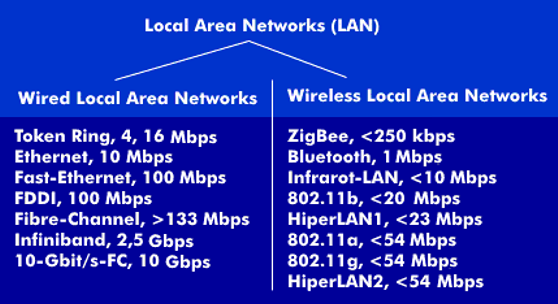local area network (LAN)
Local area networks (LANs) are systems for high- performance information transfer that enable a number of equal users to carry out a partnership-oriented exchange of messages of high quality. Local area networks are characterized by their spatial extent, the speed with which they transmit data, the structure of the architecture, the number of connectable stations and the way in which the connected stations access the transmission medium.
Local networks have a limited spatial extent and are therefore predestined for localized use in companies. The bridgeable distance between the connected stations is usually 10 km. In the case of classic Ethernet, the maximum extension is even considerably smaller due to the round-trip delay. As far as transmission speed is concerned, this value has increased from 10 Mbit/s to 400 Gbit/s since the development of Ethernet. The network architecture of local area networks has also changed. In the early years, Ethernet had a classic bus topology; Token Ring, another concept for a local area network, has had a ring topology since its development, as has FDDI. With Gigabit Ethernet, star topology was added.
Another important characteristic is the access procedure. Such an access procedure regulates the access of the connected stations to the shared transmission medium. The access procedure ensures that several stations do not access the transmission medium at the same time. The procedure can be deterministic or random. And then there is the transmission medium. Electrical cables, optical fib ers and radio are used. Wired transmission media were dominant for years and were supported by fiber opt ics to bridge long distances. It was not until WLANs, which transmit signals using radio waves, that other interesting areas of application for local area networks were opened up.
The partnership-oriented message exchange can be understood as a distinction from a hierarchically organized exchange and is another characteristic that illustrates the flexibility of a LAN: A hierarchical or semi-hierarchical structure can be built on top of an equal-partner message exchange system if required.
Conceptually, the following requirements must be met by local area networks: High bandwidth of the transmission medium for fast message transmission, a suitable topology to achieve the addressed goals, including high reliability and high modularity, suitable agreements on the communication flow, functional and procedural aids for optimal utilization of the possibilities given by transmission facilities and protocols on the part of the users, and an open system architecture to force modularity, expandability, flexibility and acceptance.

